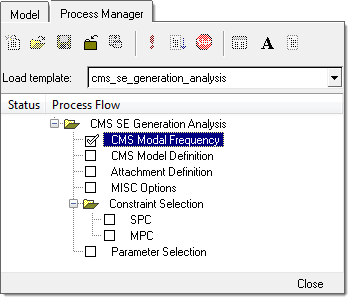CMS SE Generation Process |

|

|

|

|
|
CMS SE Generation Process |

|

|

|

|
This process template helps you generate a CMS SuperElement (SE) modal model from a finite element based model.

This task lets you select a type of CMS SE via the CMS Method pull-down menu. Select to create a fixed boundary Craig-Bamption (CBN) CMS superelement, or a mixed (free-free or fixed) boundary (GM - general modal method) CMS superelement. Once the type of the CMS SE has been selected, define the modes to be included by specifying either the upper frequency or the number of modes, as well as Spoint starting IDs to be assigned to the modes. The Spoint ID fields are auto filled with the first available ID provided by the HyperMesh database. Each mode added to the CMS SE will be assigned a Spoint ID sequentially from the starting ID, and the total number of Spoint IDs actually used will be the same as the number of modes found. Fluid modes, as well as fluid-structure coupling matrix can be included in the CMS SE by checking the Coupled fluid-structure SE checkbox, and providing the above mentioned frequency and Spoint ID definition for the fluid modes. Once the task has been completed, click Apply to proceed to the next task.
|
This task lets you specify what recovery information is to be stored in the CMS SE. Pick a set of elements, for which the keyword Plotel is a valid specification, or a set of grids. The Rigid checkbox gives you the ability to exclude/include rigid elements from the recovery set. Once the model recovery set has been defined, click Apply to proceed to the next task.
|
This task lets you specify attachment point sets. Both fixed and free-free attachments can be specified for a mixed (GM) CMS SE, while only fixed attachments can be specified for a fixed (CBN) CMS SE. Once the attachment set has been defined, click Apply to proceed to the next task.
|
This task aids you in specifying structural damping and fluid-structure coupling option. You can specify a global material damping to be assigned to all structural parts, or select the option of No damping to avoid adding any damping globally if damping has been specified at the material level for all components.
For fluid-structure coupling, choose Solver auto-search driven by the ACMODL card, or Akusmod which assumes that coupling is provided in a binary file named ftn.70.
|
This task lets you select typical solution parameters, such as title, singular point constraints, and so on. Check all boxes under the Active column to activate the desired solution option. Once the parameters have been selected, click Apply and a Process Manager message box pops up informing you that the process has come to an end. Click Yes to close the template, or No to review or edit the process steps.
|